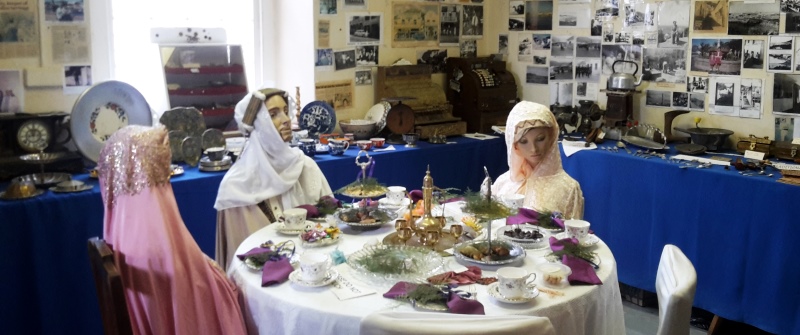
12 Jul Blog: A space to keep the culture alive
By Tom Hoogervorst
The most interesting things are often found in places least expected to harbour them. Some 40 kilometres south of Cape Town, surrounded by grass-covered hills and sandy beaches populated by penguins, lies an oasis of South Africa’s Muslim history: the Simon’s Town Heritage Museum. On appointment, its owner provides visitors with a rare glimpse into the history of a community that has called the Cape its home for over 350 years, and yet one which is becoming increasingly invisible to the outside world in the wake of apartheid and its destructive legacies.
“It all started with spices,” explains Zainab Davidson, née Amlay, who in Cape Muslim circles is better known as Aunty Patty. “The Dutch colonized the Cape in the seventeenth century in order to obtain direct access to Indonesia’s highly valued spices. And from the times of our forefathers, who made Cape Town into what it is today, right through to the present, spices have shaped our daily lives. Even our version of melktert (milk tart) is different from that of other people. Ours has spices in it!” As she walks me through the heritage-packed rooms of her Victorian-style residence-turned-museum, where the Amlay family have lived since 1858, Aunty Patty proves to be a walking encyclopaedia of her community.
Like many Muslim families in the Cape, Aunty Patty has ancestors from various parts of the world, including India and Indonesia. This unique blend of cultures, she feels, is what Cape Town is really about. “We are all mixed. This is very clear from our cuisine, which brings together Malay, Indian, African and European flavours.” Unsurprisingly, one of the museum’s rooms is dedicated to traditional cooking equipment, ingredients, crockery, utensils, and a fully set dinner table. Equally enthralling are the community’s changing fashion trends. Through archival pictures and actual displays of wedding gowns, headgear and religious attire, the museum showcases in colourful detail how Cape Muslims have dressed over the centuries.
Aunty Patty has been instrumental in re-establishing connections across the Indian Ocean. She immediately loved Indonesia when she first set foot in this country from which the ancestors of so many of the Cape’s early families originated. As a connoisseur of artisanship – the museum houses numerous tools for carpentry, embroidery, and sewing – she was particularly impressed by the care Indonesian craftspeople take with their work, even in modern times. She also admired people’s politeness and greatly enjoyed the food. In fact, the museum has become a must-see for Indonesian and Malaysian delegations, who marvel at its beautifully handwritten religious books (kitaabs). To their amazement, the older generations of Cape Muslims still remember a number of Malay words – including piesang (banana), toelies (to write), and trama kasie (thank you) – despite centuries of severed ties and the fact that their present-day language is as diverse as their cuisine, incorporating elements from Afrikaans, Indian languages, Portuguese, English and Malay.
But this museum is more than a repository of cultural curiosities. Rather than wallowing in nostalgia, it addresses the gloomier sides of history head-on. As any visitors to it will learn, apartheid caused irreparable damage to the Cape Muslim communities. Under the dreaded Group Areas Act, historically tight-knit residential areas, such as Simon’s Town, District Six, and Kimberley’s Malay Camp, were declared ‘white areas’, leading to forced evictions, scattered families, and disrupted cultural practices. Even today, many of these once vibrant localities resemble “a hollow residue of a displaced community”. And, up until this day, Cape Muslim communities are being pushed out of their ancestral homes – most notably in the Bo-Kaap area of Cape Town’s inner city – by exorbitant property prices, increases in rent, and a blatant disregard for the heritage of historical neighbourhoods.
If any lesson can be drawn from this ongoing struggle, it is that spaces where the culture can be kept alive and dynamic for future generations are needed now more than ever. Aunty Patty is among many who worry about the Cape’s unique Muslim heritage: “Who is going to take it over? I’m in my eighties now.” A quick glance at one of the walls of the living room, which is filled with photos of young, successful community members, possibly provides the answer.
Photo: Tom Hoogervorst.
(Tom Hoogervorst focuses on language contact and Malay linguistics. He is currently studying the development of the (Indonesian) Malay language through the KITLV’s collection of Sino-Malay literature, while simultaneously attempting to cast a new light on cultural contact, the introduction of new concepts and the role of popular culture during late 19th and early 20th centuries.)




No Comments